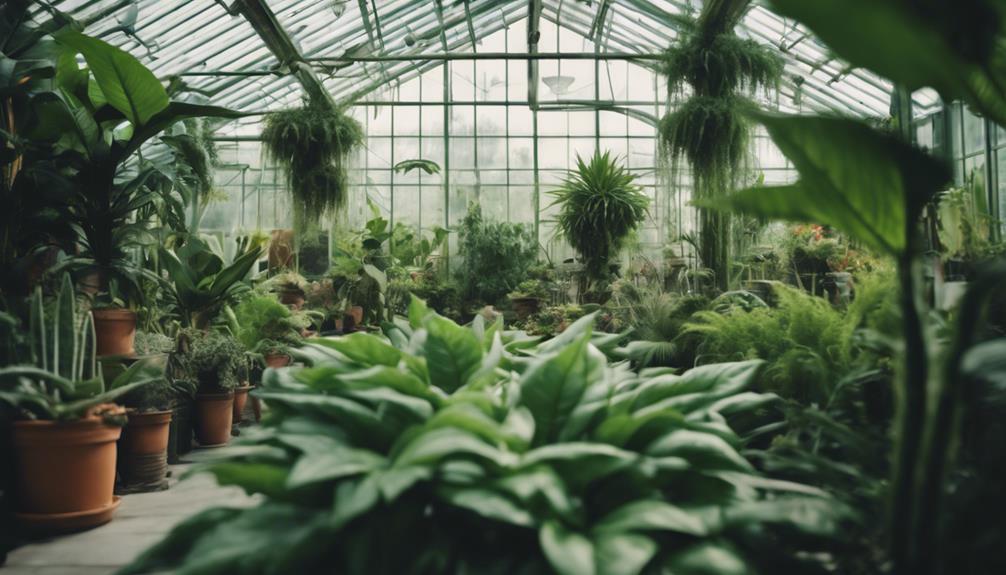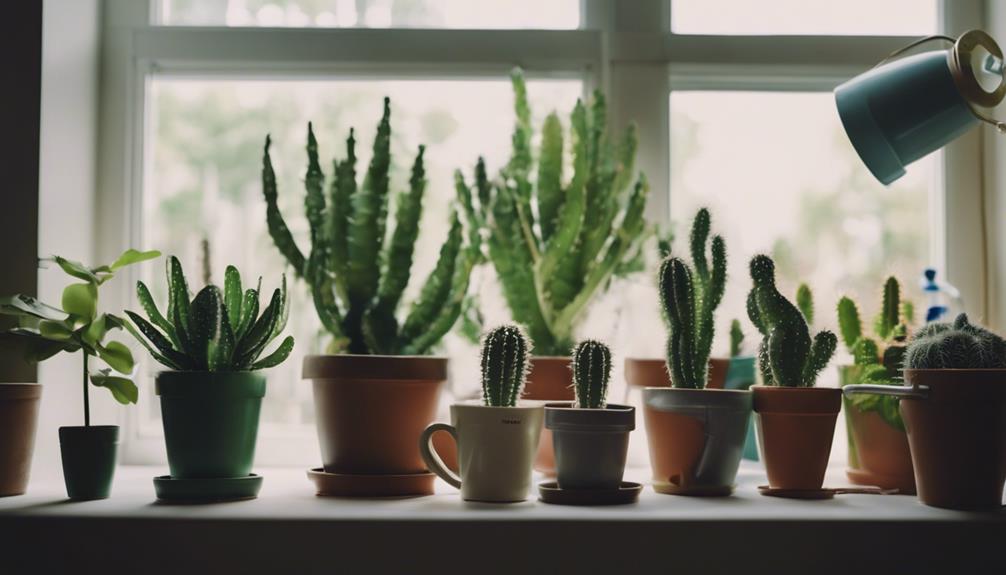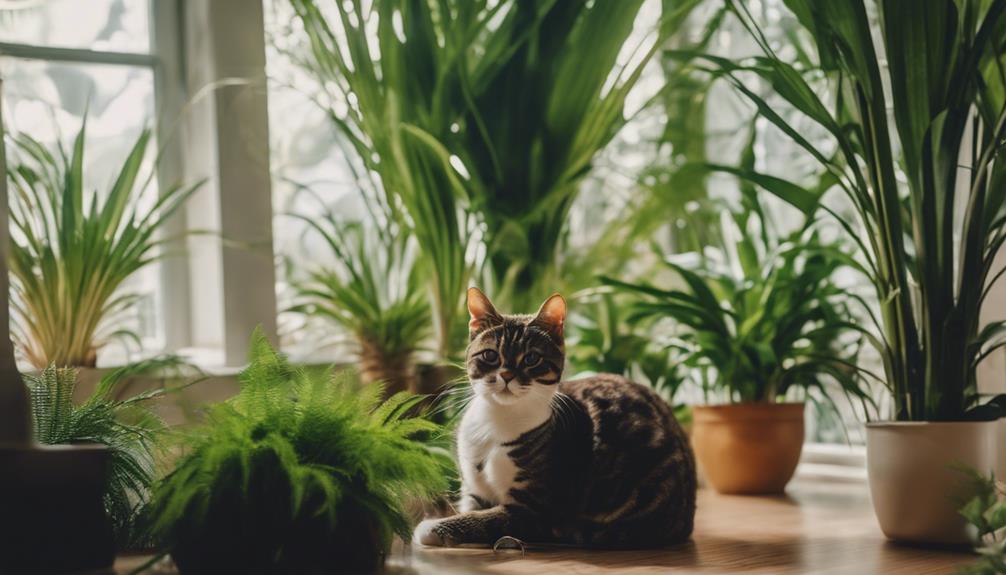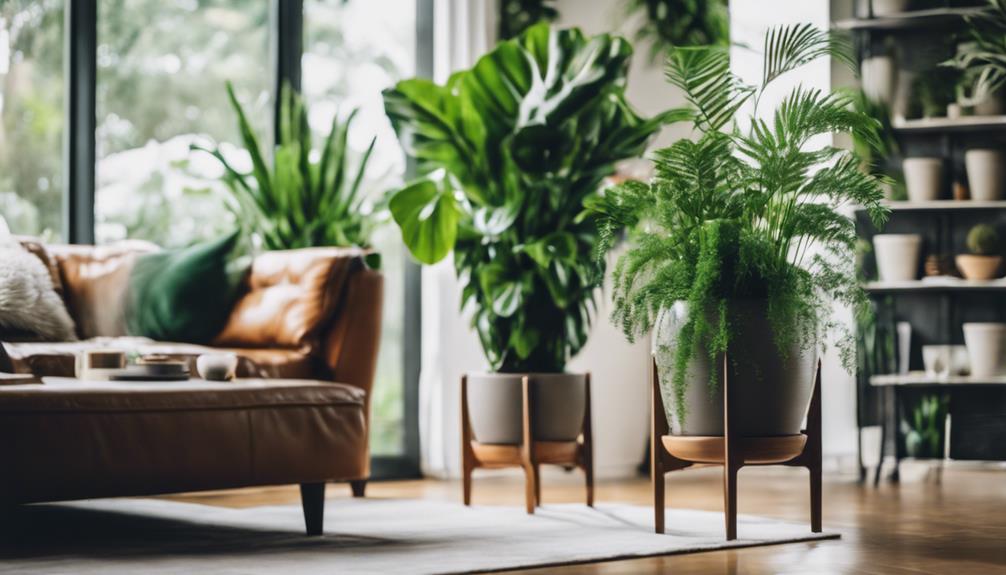When looking for large indoor plants to enhance your space, consider reputable online retailers such as The Sill and PlantX, specialty nurseries, Home Depot, and botanical gardens for unique statement plants. Exclusive boutiques and high-end design studios also offer exceptional options. Sustainable plant subscription services can provide a steady supply of greenery. For those who enjoy do-it-yourself projects, delving into plant propagation techniques and participating in plant swaps can be fulfilling. By exploring these avenues, you can discover the ideal large indoor plants to create a striking statement in your indoor sanctuary.
Key Takeaways
- Top sources like The Sill and Home Depot offer XL indoor greens.
- Specialty nurseries and botanical gardens provide unique plant varieties.
- Seek expert care advice for maintenance and troubleshooting.
- Interior design studios offer guidance for selecting the perfect statement plant.
- Consider sustainable plant subscription services for curated XL indoor greens.
Top Online Retailers for XL Indoor Greens
When looking for XL indoor greens, we turn to top online retailers that offer a diverse selection of statement plants. The Sill, Bloomscape, and PlantX are excellent choices for finding that perfect Money Tree, Bird of Paradise, or Swiss Cheese Plant to elevate our indoor spaces.
These retailers make it easy to browse through various sizes, pot options, and care instructions, ensuring we can select the ideal plant for our home or office.
With delivery services provided by many online retailers, our chosen XL indoor greens are delivered right to our doorstep, arriving safely and ready to thrive in their new environment.
Shopping online for these statement plants allows us to compare prices, explore different plant varieties, and read customer reviews to make well-informed decisions.
Whether it's adding a touch of tropical paradise with a Bird of Paradise or bringing a bit of nature indoors with a Swiss Cheese Plant, these top online retailers have us covered with their wide array of XL indoor greens.
Specialty Plant Nurseries Near You
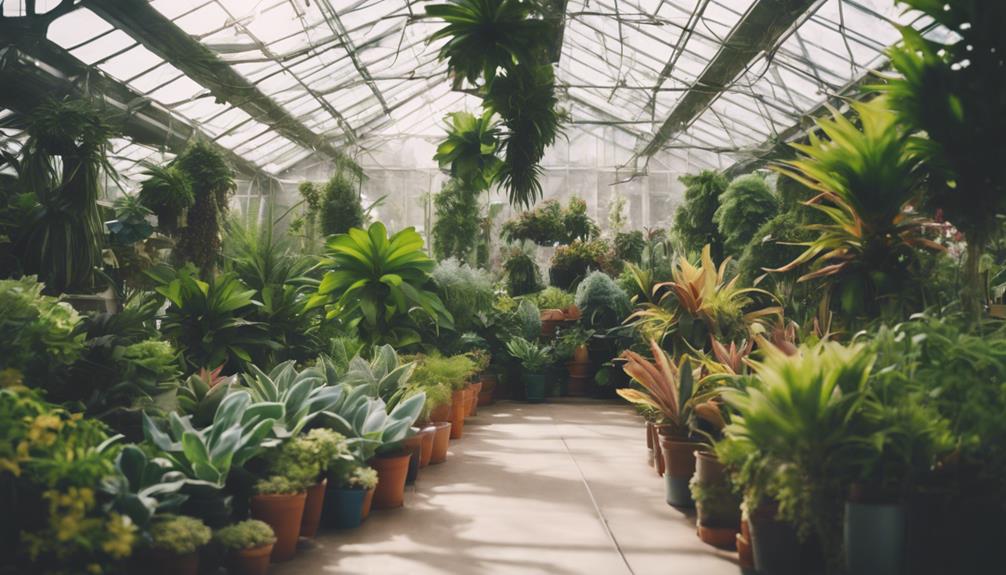
When looking for XL indoor greens, checking out specialty plant nurseries near you is a great start.
These nurseries offer a diverse selection of top plant varieties, including unique options and rare finds.
Plus, you can benefit from expert care guidance to make sure your statement plants thrive in your home.
Local Nursery Options
For those seeking XL indoor greens, exploring local nursery options can lead to discovering unique and exotic plant varieties. Specialty nurseries are excellent places to find statement plants that may not be available at regular garden centers. These nurseries offer a wide selection of large indoor greens, and their knowledgeable staff can provide valuable guidance on caring for and displaying these plants.
One advantage of local nurseries is the opportunity to see the actual size and condition of the XL indoor greens before making a purchase. This hands-on experience can help you choose the perfect plant for your space. Additionally, many specialty nurseries provide delivery services for those who may find transporting large plants challenging.
Visiting a local nursery not only allows you to browse through a diverse range of options but also supports your community's green spaces.
Top Plant Varieties
Specialty plant nurseries near us offer a diverse selection of XL indoor greens, showcasing unique and rare plant varieties for indoor spaces. When exploring these specialty nurseries, you can find a variety of top plant varieties to create your own indoor jungle.
Some popular XL indoor greens available at these nurseries include:
- Fiddle Leaf Figs
- Monstera Deliciosas
- Bird of Paradise plants
- Rubber Trees
These specialty nurseries focus on providing high-quality plants that aren't only visually stunning but also well-suited for indoor environments. Whether you're looking to sell or share the beauty of these statement plants, visiting a specialty nursery can help you find the perfect XL indoor green to elevate your space.
With expert advice on hand, you can confidently choose the right plant to transform your indoor space into a lush oasis.
Expert Care Advice
At specialty plant nurseries near us, we can access expert care advice for selecting and maintaining XL indoor greens. The knowledgeable staff at these nurseries offer personalized recommendations tailored to our specific indoor environment and plant preferences. They can assist with determining the ideal light exposure, creating proper watering schedules, and providing essential plant nutrition to ensure our statement plants thrive. If any issues arise with our XL indoor greens, these experts are on hand to troubleshoot and offer effective solutions for optimal plant care. Visiting a specialty plant nursery not only allows us to explore a diverse selection of XL indoor greens but also enables us to seek guidance on choosing the perfect statement plant for our space.
| Expert Care Advice at Specialty Nurseries | |
|---|---|
| Personalized Recommendations | Tailored advice based on individual needs |
| Troubleshooting Assistance | Expert help with any plant care issues |
| Selection Guidance | Assistance in choosing the right plants |
Home Improvement Stores With XL Plants
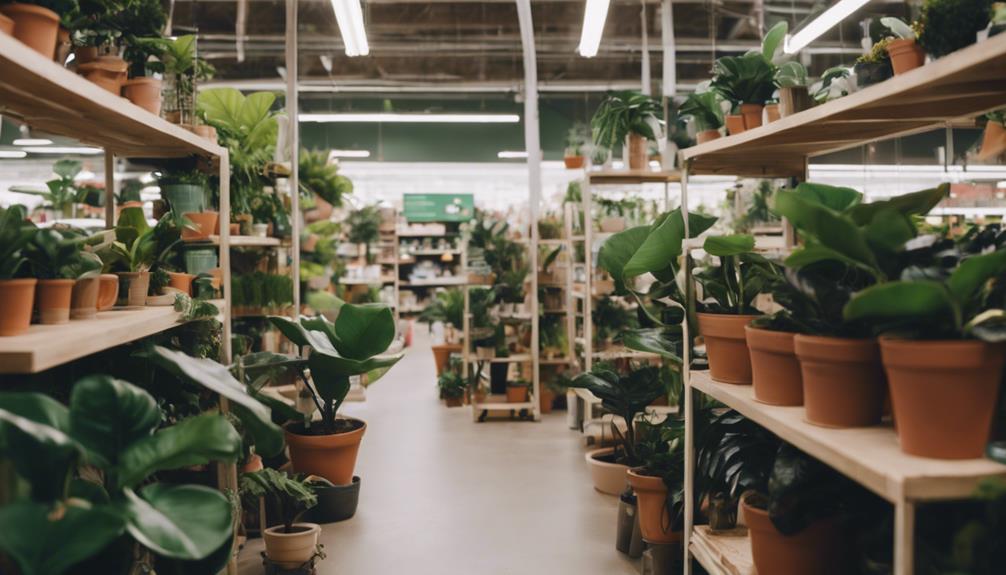
At home improvement stores like Home Depot and Lowe's, we can find a diverse selection of XL indoor plants to elevate our living spaces.
When choosing plants, consider factors such as light requirements, humidity levels, and overall care needs to guarantee their well-being.
Additionally, seek out advice from store experts on plant care tips and maintenance to keep your XL greens thriving in their new home.
Store Selection Tips
When looking for XL indoor plants, consider exploring home improvement stores like Lowe's and Home Depot for a wide selection of large plant options. These stores offer a variety of choices, including the majestic Majesty Palm, elegant Spathiphyllum Peace Lily, sturdy Sansevieria Snake Plant, and unique Philodendron Monstera Swiss Cheese Plant.
You can also find the regal Ravenea Majesty Palm to add a touch of sophistication to your indoor space. At Lowe's and Home Depot, you'll come across large indoor plants that stand at least 48 inches tall or even taller, making them perfect statement pieces for your home. Whether you prefer flowering plants to add a pop of color or non-flowering varieties for a green touch, these stores have options to suit your style.
Additionally, if you have pets, look out for pet-friendly plant choices to guarantee a safe environment for your furry friends.
Plant Care Advice
For thriving XL indoor plants purchased from home improvement stores like Home Depot and Lowe's, apply proper plant care techniques to guarantee their health and longevity. These statement plants, ranging from Majesty Palms to Monstera Swiss Cheese Plants, require specific care to thrive indoors.
Make sure they receive adequate sunlight, water, and occasional fertilization to promote growth. XL indoor plants can add a touch of greenery to any room, but it's crucial to take into account their individual needs. Majesty Palms and Peace Lilies are pet-friendly options that can coexist safely with your furry friends.
Regularly dust the leaves, check for pests, and repot as needed to maintain their health. Home improvement stores offer a variety of large indoor plants, such as Bird of Paradise and Bamboo Palm, perfect for creating a lush indoor oasis.
Botanical Gardens Offering Large Indoor Greens

Exploring botanical gardens reveals a fascinating array of large indoor greens, showcasing an impressive collection of statement plants in beautifully curated displays. These gardens offer a diverse selection of oversized indoor plants, each adding its unique charm to the lush greenery.
Some common finds include Majesty Palms, Peace Lilies, Snake Plants, Monstera Swiss Cheese Plants, and Majesty Palm Plants. Here, visitors can admire and draw inspiration from the vibrant foliage of plants like Dracaena Gold Star and Bromeliad Aechmea Pink, carefully arranged in decorative pots for a visually striking experience.
- Majesty Palms
- Peace Lilies
- Snake Plants
- Monstera Swiss Cheese Plants
These botanical gardens often feature statement plants like Bamboo Palms and Bird of Paradise, strategically placed to create focal points and add a touch of drama to indoor spaces. The grandeur of these large indoor greens makes them standout pieces in any botanical garden setting.
Exclusive Plant Shops for Statement Pieces
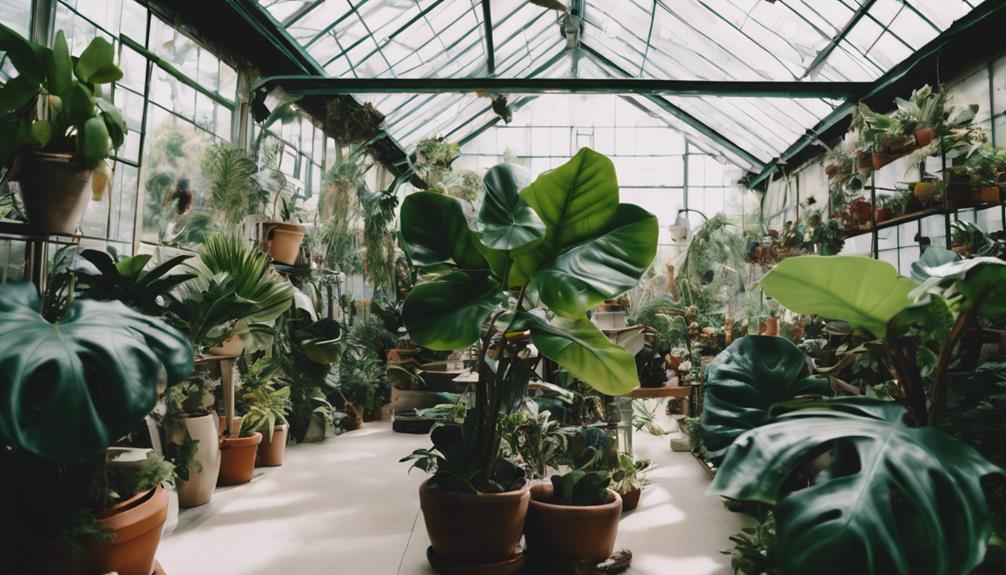
At exclusive plant shops, you can find a curated selection of XL indoor greens for statement pieces. These specialty shops pride themselves on sourcing unique and rare plant varieties to elevate the aesthetic of your indoor space.
The plants offered by these exclusive shops are specifically chosen to serve as focal points in home decor, making a bold visual impact with their larger size. By exploring the collections at these establishments, you can discover the perfect XL indoor greens to suit your space and style preferences.
Whether you're looking for a towering fiddle leaf fig or a lush monstera deliciosa, these shops offer a range of options to cater to different tastes. Investing in a statement plant from an exclusive shop not only adds a touch of greenery to your home but also brings a touch of sophistication and elegance to your living environment.
Sustainable Plant Subscription Services

Let's explore the world of sustainable plant subscription services, where plant enthusiasts can conveniently receive a variety of indoor plants on a regular basis. These services cater to individuals looking to enhance their indoor spaces with greenery while prioritizing sustainability.
Here are some key aspects of sustainable plant subscription services:
- Customizable Selection: Subscribers have the freedom to choose from different plant sizes, types, and subscription frequencies based on their preferences.
- Eco-Friendly Practices: Many services prioritize eco-conscious packaging and practices to reduce environmental impact, ensuring a more sustainable plant delivery experience.
- Plant Care Guidance: Subscribers often receive plant care instructions and tips to help them nurture and maintain healthy plants, making it easier for both beginners and experienced plant owners.
- Convenient Expansion: Sustainable plant subscription services offer a convenient way for plant lovers to expand their indoor greenery collection without the hassle of frequent plant shopping trips.
These services provide a practical and eco-friendly solution for those looking to bring the beauty of nature into their homes continuously.
High-End Interior Design Studios for XL Greens

Sustainable plant subscription services cater to plant enthusiasts seeking a convenient way to receive a variety of indoor greens regularly, while high-end interior design studios specialize in curating XL indoor greens for luxurious spaces.
These design studios offer a curated selection of statement plants, carefully sourced to elevate the aesthetic of any room. Expect to find a range of exotic and rare plant varieties that are perfect for creating a sophisticated indoor oasis. Interior design experts at these studios can provide guidance on plant selection and placement, helping enhance your home decor with greenery that exudes opulence.
Investing in XL indoor greens from these high-end studios adds a touch of luxury to your living space, transforming it into a lush and elegant sanctuary. If you're looking to elevate your interior design with stunning, oversized plants, these specialized studios are the perfect place to find unique botanical pieces that will make a bold statement in your home.
DIY Plant Propagation Techniques
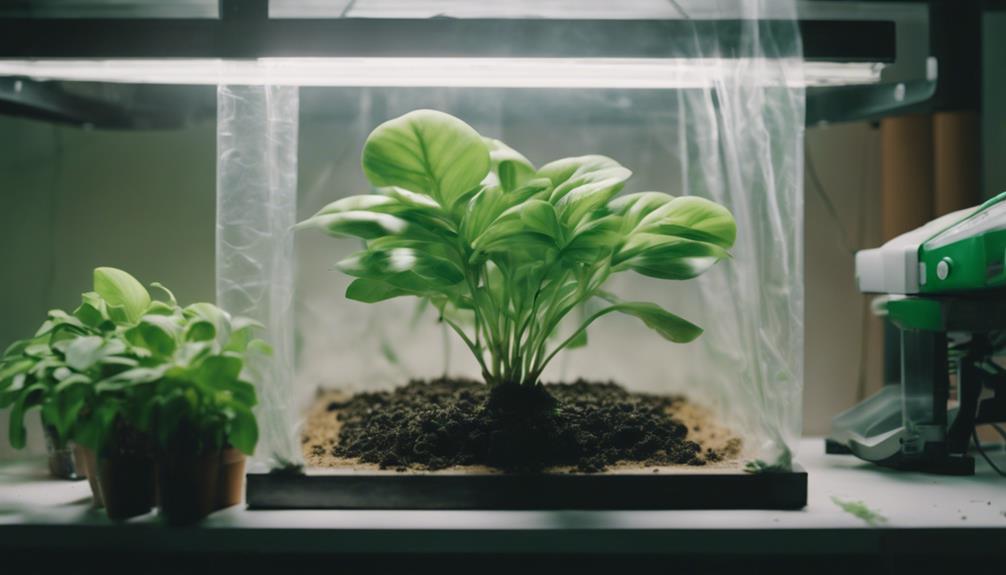
Exploring various DIY plant propagation techniques allows plant enthusiasts to multiply their indoor greenery collection through simple yet effective methods.
Here are some common techniques you can try:
- Stem Cuttings: Take a piece of a plant's stem with nodes and leaves, then place it in water or soil to encourage root growth.
- Leaf Cuttings: Detach a healthy leaf from a plant and let it root in water or soil, eventually sprouting into a new plant.
- Division: Split a mature plant into smaller sections with roots to create multiple new plants.
- Air Layering: Encourage a part of a plant stem to grow roots while still attached, then separate it to form a new plant.
Unique Plant Swaps and Exchanges
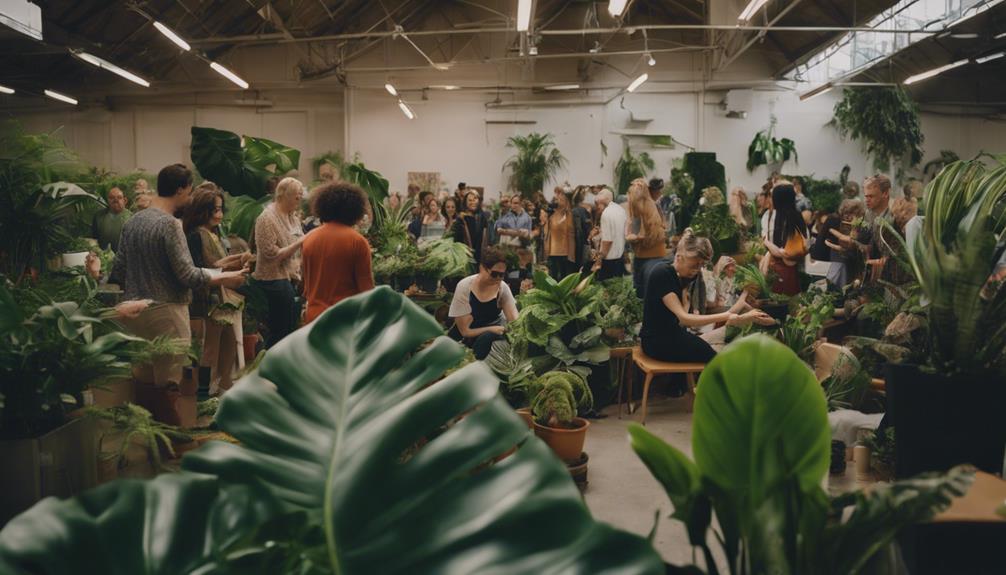
Joining plant swap communities introduces enthusiasts to a world of rare and unique XL indoor greens. By connecting with local plant lovers or joining online platforms, you can trade your excess indoor plants for new varieties, expanding the diversity of your collection.
These exchanges offer an exciting opportunity to discover interesting plants that may not be easily accessible through traditional avenues. Whether attending organized swap events or hosting your own, these gatherings provide a platform to exchange XL indoor greens with fellow enthusiasts, fostering a sense of community and shared passion for botanical treasures.
Additionally, exploring specialized plant exchange platforms or apps can further enhance your options for trading, buying, or selling unique indoor greens. Embracing these unique plant swap and exchange opportunities opens doors to a whole new world of botanical wonders, allowing you to curate a distinctive indoor garden that reflects your individual taste and style.
Frequently Asked Questions
What Is the Difference Between Harvest and Harvest Xl?
The difference between the Harvest and Harvest XL models lies in several key features.
The Harvest XL, priced at $139.95, offers a larger bowl for increased water capacity and more plant spacing on its grow deck.
It also boasts an adjustable grow height of 18 inches, accommodating up to 6 different plant varieties for a wider range of planting options compared to the regular Harvest model.
What Is the Easiest Indoor Plant to Keep Alive?
When looking for the easiest indoor plant to keep alive, consider options like Snake Plants, ZZ Plants, and Aloe Vera. These low-maintenance plants require minimal watering and can thrive in various light conditions.
Pothos and Spider Plants are also resilient choices for beginners, forgiving of occasional neglect.
Peace Lilies offer air-purifying benefits with straightforward care needs.
Choose Philodendrons or Chinese Evergreens for adaptability and forgiveness, making them great for new plant owners.
What's the Easiest Plant to Grow Indoors?
When it comes to growing plants indoors, herbs like basil, mint, and parsley are fantastic choices for beginners. These herbs are resilient, adaptable, and thrive in indoor settings with proper care. They can be grown in small spaces like kitchens or windowsills, requiring minimal maintenance.
With the AeroGarden Harvest XL, cultivating herbs indoors becomes effortless, providing a year-round supply of fresh and flavorful greens for cooking and garnishing meals.
What to Grow in Aerogarden Farm Xl?
We like growing a mix of herbs and veggies in our AeroGarden Farm XL. The larger bowl and grow deck make it easy to experiment with different plants.
We've had success with basil, thyme, lettuce, and cherry tomatoes. The adjustable grow height and built-in light cycle create the perfect environment for these greens to thrive.
Plus, the hassle-free setup means we can enjoy fresh indoor greens without any gardening skills.
What Are the Best Indoor Plants for XL Houseplants?
When considering how much water for houseplants, it’s important to choose the right ones for your XL space. Some of the best indoor plants for XL houseplants include the Snake Plant, Fiddle Leaf Fig, and Rubber Plant. These plants can thrive in larger spaces and add a touch of greenery to your home.
Conclusion
To wrap things up, finding XL indoor greens to make a statement in your home is easier than you think. Whether you shop online, visit a local nursery, or even try your hand at DIY propagation, there are plenty of options to choose from.
With a little creativity and a touch of green thumb magic, you can transform your living space into a lush oasis that will impress all who enter.
Happy planting!
